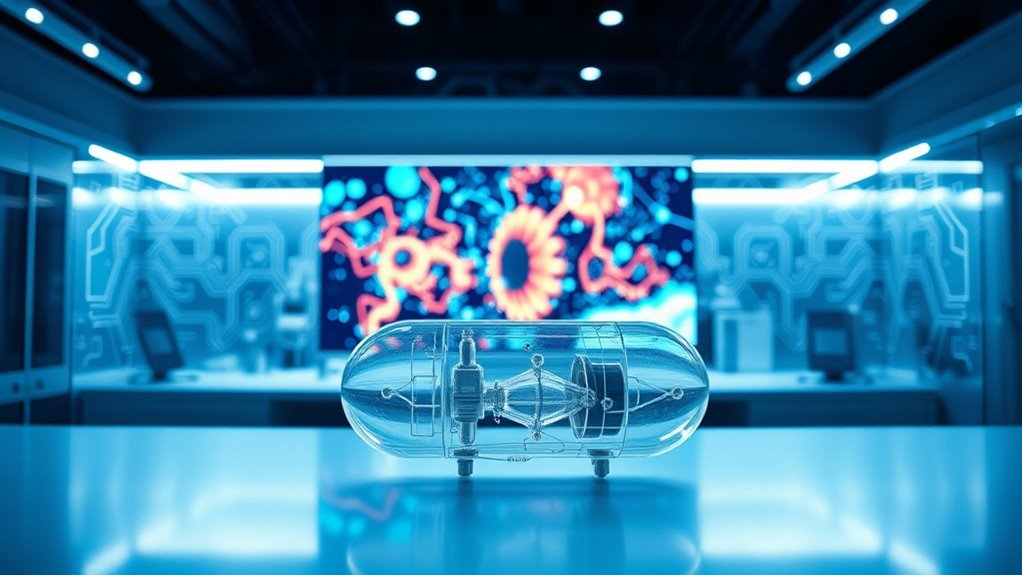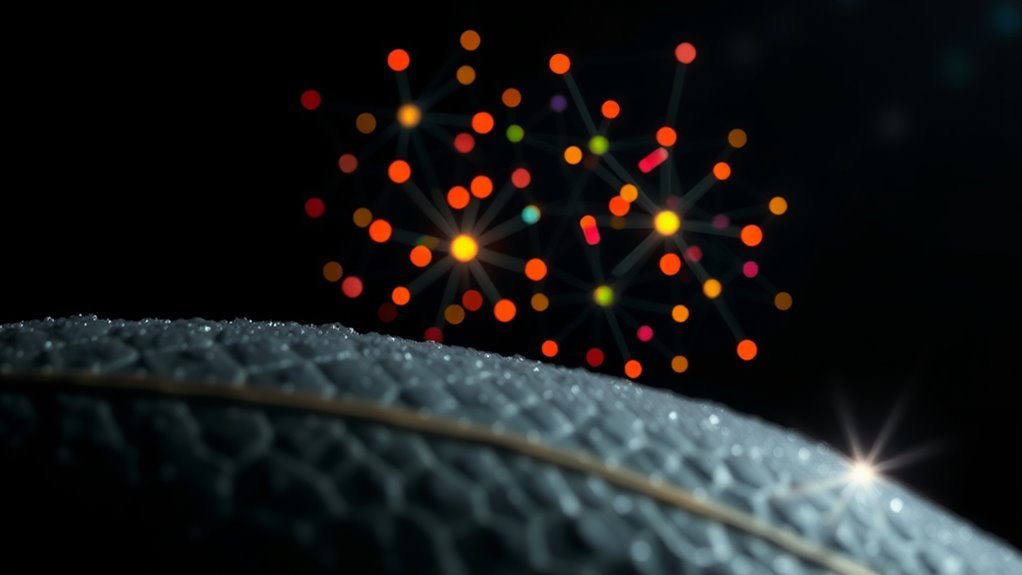You can improve image analysis accuracy by implementing capsule networks, which capture spatial hierarchies and pose relationships better than traditional CNNs. Capsules represent features as vectors, preserving orientation and part-whole relationships, while dynamic routing refines information flow. Though training poses challenges like instability and higher computational costs, capsule networks offer robustness to distortions and viewpoint changes. By leveraging their architecture, you’ll enhance recognition performance in complex tasks. Explore key components, training techniques, and evaluation methods to optimize your implementation.
Understanding the Basics of Capsule Networks

Capsule networks represent a significant advancement in neural network architecture designed to improve the way spatial hierarchies are modeled in image analysis. When you engage with capsule network fundamentals, you tap into a system that captures not only the presence of features but also their spatial relationships and orientations. Unlike traditional convolutional networks, capsule networks mimic aspects of visual perception models by preserving hierarchical pose information, enabling more robust recognition despite variations in viewpoint or deformation. This approach grants you greater freedom to analyze complex images with higher accuracy, as the network’s capsules function as groups of neurons that encode instantiation parameters. Understanding these basics sets the foundation for leveraging capsule networks to overcome limitations found in conventional architectures, ultimately enhancing your image analysis capabilities.
Key Components of Capsule Network Architecture

You’ll first encounter capsule layers, which group neurons to capture spatial hierarchies in data. Then, the dynamic routing mechanism directs information flow between capsules, ensuring relevant feature relationships are preserved. Understanding these components is essential for grasping how capsule networks outperform traditional models in image analysis.
Capsule Layers Explained
While traditional convolutional layers focus on detecting features, capsule layers group neurons into small vectors, capturing not only the presence but also the spatial orientation and hierarchical relationships of those features. Understanding capsule layer functions is essential for leveraging their power in image analysis. Capsule layer types primarily include primary capsules, which extract low-level features, and higher-level capsules, which model complex objects through part-whole relationships. Here’s what you need to know:
- Primary Capsule Layer: Converts scalar outputs into vector capsules, encoding pose information.
- Convolutional Capsule Layer: Maintains spatial hierarchies by processing capsules in localized receptive fields.
- Fully Connected Capsule Layer: Integrates features globally, enabling object-level understanding.
Dynamic Routing Mechanism
Because understanding feature relationships is crucial, the dynamic routing mechanism plays a central role in capsule networks by enabling capsules to selectively route their outputs to appropriate higher-level capsules. You’ll leverage dynamic routing strategies that iteratively adjust coupling coefficients based on agreement between lower- and higher-level capsule predictions. This process guarantees that only relevant features contribute to the final representation, enhancing the network’s ability to model part-whole relationships. By implementing efficient routing algorithms, you optimize capsule network performance, reducing information loss and improving robustness. Dynamic routing also facilitates better generalization in complex image analysis tasks, as it adapts connections dynamically rather than relying on static weights. Incorporating these routing strategies is critical for capsule network optimization, granting you greater control over feature hierarchies and ultimately elevating accuracy in image recognition.
How Capsule Networks Differ From Traditional CNNS

Although traditional Convolutional Neural Networks (CNNs) have revolutionized image analysis, they often struggle with recognizing spatial hierarchies and pose variations. Capsule architecture addresses these challenges by representing features as vectors rather than scalars, capturing orientation and spatial relationships more effectively. When you compare capsule networks to traditional CNNs, consider these key differences:
- Feature Representation: Capsules encode instantiation parameters, allowing you to preserve pose and deformation information, unlike scalar activations in traditional CNNs.
- Dynamic Routing: Instead of fixed pooling, capsules use routing-by-agreement, which dynamically adjusts connections based on feature agreement.
- Hierarchical Understanding: Capsule layers model part-whole relationships explicitly, providing you a richer spatial hierarchy than traditional CNNs’ flat feature maps.
This structural shift empowers you to analyze images with more nuanced spatial understanding.
Advantages of Capsule Networks in Image Analysis
You’ll find that capsule networks excel by capturing enhanced spatial hierarchies, preserving the relationships between object parts more effectively than traditional methods. They also offer robustness to image variations, such as rotations and distortions, improving recognition accuracy in diverse conditions. These advantages make capsule networks particularly suited for complex image analysis tasks.
Enhanced Spatial Hierarchies
When you analyze images, capturing spatial hierarchies accurately is essential for understanding object relationships and pose variations. Capsule networks excel here by preserving spatial relationships through their unique architecture, enhancing your visual perception. They use groups of neurons—capsules—that encode both the presence and the pose of features, enabling you to interpret complex structures more effectively.
Here’s why enhanced spatial hierarchies matter:
- Capsules maintain part-to-whole relationships, improving recognition of overlapping or occluded objects.
- They encode pose information, allowing you to distinguish objects regardless of orientation or viewpoint.
- Dynamic routing between capsules refines feature grouping, supporting precise spatial arrangement interpretation.
With capsule networks, you gain a model that respects the inherent spatial structure of images, empowering you with more accurate and meaningful analysis.
Robustness to Image Variations
Because real-world images often contain variations like noise, lighting changes, and distortions, your analysis method must handle these effectively. Capsule Networks inherently improve robustness to image distortions by encoding spatial hierarchies and preserving pose information within capsules. Unlike traditional convolutional networks, capsules maintain viewpoint invariance, allowing you to recognize objects regardless of orientation or scale changes. This capability reduces sensitivity to common perturbations and guarantees consistent performance across diverse imaging conditions. By leveraging dynamic routing mechanisms, capsule networks selectively emphasize relevant features despite variations, enhancing reliability. Consequently, when you implement capsule networks, you gain a model better equipped to generalize across distorted inputs and varying viewpoints, providing more accurate and stable image analysis in unpredictable real-world environments.
Common Challenges in Training Capsule Networks
Although capsule networks offer promising advances in image analysis, training them effectively remains challenging due to their complex architecture and routing mechanisms. You’ll face several obstacles that require careful consideration:
- Training Instability & Convergence Challenges: The dynamic routing algorithm can cause unstable gradient flow, making convergence slow and unpredictable. Hyperparameter tuning becomes critical here.
- Overfitting Issues & Data Augmentation: Capsule networks often demand extensive data augmentation to prevent overfitting, given their sensitivity to input variations.
- Computational Complexity & Resource Requirements: Their intricate structure increases computational load, leading to higher resource consumption and implementation difficulties. Additionally, model interpretability is still limited, complicating debugging and refinement.
Understanding these challenges allows you to strategize effectively, balancing performance gains against practical constraints.
Step-by-Step Guide to Building a Capsule Network
Since capsule networks rely on specialized routing algorithms and multi-dimensional capsules, you’ll need to carefully design each layer to preserve spatial hierarchies and pose information. Start by selecting a reliable capsule network framework, then preprocess your training dataset to maintain object orientation integrity. Use dynamic routing between capsules to refine feature representation.
| Step | Key Focus |
|---|---|
| 1. Choose Framework | Select robust capsule network frameworks supporting dynamic routing |
| 2. Prepare Data | Verify training dataset considerations include pose variance and complexity |
| 3. Layer Design | Build capsule layers preserving spatial hierarchies with squash activation |
Evaluating Performance and Accuracy Improvements
When you evaluate capsule networks, focus on metrics that capture both accuracy and robustness to pose variations. This dual focus guarantees you’re measuring true performance improvements. Use these performance metrics to gauge effectiveness:
- Accuracy Benchmarks: Compare against baseline CNNs to quantify gains in classification precision.
- Robustness Tests: Assess how well the network handles rotated or transformed inputs, reflecting real-world variability.
- Computational Efficiency: Measure inference time and resource consumption to balance accuracy with practical deployment needs.
In addition, incorporating continuous monitoring can help ensure sustained performance and quickly detect any degradation during deployment.
Practical Applications of Capsule Networks in Industry
Because capsule networks capture spatial hierarchies more effectively than traditional CNNs, they’re particularly suited for complex image analysis tasks in industries like healthcare, autonomous vehicles, and manufacturing. You can leverage capsule networks for medical imaging to enhance tumor detection accuracy and for autonomous vehicles to improve object recognition in dynamic environments. In retail inventory management, capsule networks enable precise product identification despite occlusions. They also bolster facial recognition systems by preserving pose and orientation information, improving fraud detection through nuanced pattern recognition. Agricultural monitoring benefits from their ability to analyze crop health from aerial images, while industrial automation utilizes them for defect detection in manufacturing lines. Additionally, sports analytics can extract detailed player movement data. Integrating capsule networks in these domains empowers you with robust, spatially-aware image analysis that enhances decision-making and operational efficiency. Leveraging cloud platforms with scalability options allows seamless deployment and management of capsule network models in real-world applications.
Future Trends and Research Directions in Capsule Technology
As capsule networks continue to evolve, you’ll see growing emphasis on improving their scalability and computational efficiency to handle increasingly complex image datasets. Addressing scalability challenges will open up future applications across diverse domains. Key future directions include:
Future capsule networks will focus on scalability and efficiency to manage complex image data effectively.
- Algorithm advancements integrating emerging technologies to enhance performance benchmarks and reduce computational overhead.
- Expanding research collaborations and interdisciplinary approaches, fostering innovation through education initiatives and community engagement.
- Strengthening industry partnerships to translate theoretical models into practical tools, accelerating adoption in real-world scenarios.



